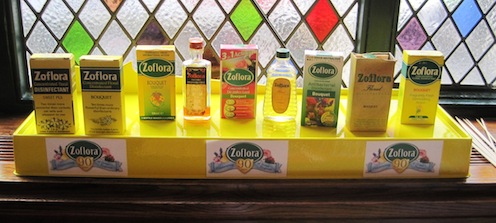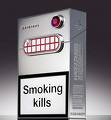ZOFLORA, the home
cleanliness experts, mark 90 years of keeping British homes armed against nasty bugs and
bacteria. Their little bottles of household
disinfectant have become one of the nation’s favourites since the company’s founding in 1922. Below you can see photos of how the range has changed over time.
But have the nation’s cleaning habits changed since then? Well according to a recent study by Zoflora, we are still at risk, with our homes “a hotbed of potentially dangerous bacteria and
viruses with all too many people failing to eliminate them through proper cleaning.”
Bacteria and viruses can trigger sometimes serious health problems unless they are eliminated from surfaces around the house. The
World Health Organisation says that about 40% of food-related outbreaks occur in the home.
To paint a picture of the attitudes and habits of householders when it comes to cleanliness and tidiness, Zoflora commissioned a study of 2,000 adults from across the
UK. Ninety percent of study respondents admitted their homes were not clean with just 5% noting their home was spotlessly clean and 6% highlighting that they were immaculately tidy.
• Two thirds (66%) of us reckon our homes should be cleaner than they are.
• One in five (19%) of us admit our homes are not clean at all.
Dirty dish cloth shock
The same research also found that 20% of people clean with the same cloth for over a fortnight without disinfecting it or replacing it and wet cloths are one of the biggest breeding grounds for microbes in the home!
Smells…
In the same Zoflora research study, just two in 10 (20%) correctly agreed with the statement that ‘a bad smell in the house meant that surfaces were unhygienic’. By far, the two most common causes of unpleasant household smells were old food in the bin (20%) and pets (20%). Other reasons included young children and toilet smells.
However, when asked what they did when they had a bad smell in the home, less than one quarter of people (23%) said they would clean the location or cause of the bad smell. Other ways of dealing with the smell included opening windows (25%), burning a fragrant candle (19%) and spraying perfume or even deodorant around the home (7%). However, while scents can mask a smell they don’t address the cause of the problem, leaving potentially harmful bacteria lurking and multiplying.
Mess...
Very few people are happy with an untidy and unclean house.
• One third (33%) said it made them feel stressed
• 20% felt anxious
• 13% felt depressed.
The aspects that worry people the most about having an untidy or messy home are that others may come round and see an unclean house (28%) or that the clutter makes them feel trapped (28%). Just 16% are most worried that it could be unhygienic. Just under one-third of people (32%) admit that having an unclean house can keep them awake at night. Of these people four in five (81%) have got up at some time between midnight and 4am.
Fewer than one in ten (8%) said they employed a cleaner, with the most common reason not to have one being given as not being able to afford one (46%).
• Nearly a quarter (23%) said that pride stopped them from having a cleaner and they were quite capable of looking after their own home while 17% said they did not like the idea of a stranger in their home.
• Of those with a cleaner, more than half (60%) said they cleaned around the house a bit before the cleaner arrived because they were embarrassed about the state of their home.
The importance of fragrance
The majority of people like rooms to smell good (71%), and nearly one in five (18%) said they would walk out of a room if it had a bad smell. A quarter of people (26%) said that smell affected their mood. When it comes to scent choices, the Zoflora research study found that:
♣ Linen fresh is the most popular choice of how people would like their homes to smell, followed by:
¥ Warm Cinnamon
¥ Lavender
¥ Cherry Blossom
Zoflora fragrance and home bacteria expert, Nicola Hobbs notes: “Our homes are fertile breeding grounds for bacteria to grow and multiply. Common microbes found in our houses include ‘superbug’
methicillin – resistant Staphylococcus aureus (MRSA) and bacteria like
Campylobacter, a common source of food poisoning. A study commissioned by Zoflora found that a shower head had 300,000 times more bacteria than a set of front door keys – bacteria thrive in warm, damp places. Research has shown that flushing a toilet sends a spray of water droplets into the air which may be contaminated with bacteria and viruses, and that these germs can float around in the bathroom for at least two hours after each flush before landing on surfaces. A study of 60 kitchens where raw chicken was prepared found that bacteria were frequently spread around – and that cleani
ng with detergent and hot water had little effect compared with the cleaning action of a disinfectant.
“There is no getting away from it: homes are havens for bacteria. That said, with the right cleaning routine and the best products, bacteria needn’t be left to thrive to the point where they become a health hazard. It’s important to clean the home regularly and frequently and use a disinfectant that is proven to work on bacteria and viruses. Bad smells can be an important sign of bacteria present on a surface or area in the house, so it’s crucial it’s dealt with properly. Simply masking the smell with an air freshener or other scents is no good – it’s crucial the cause of the problem is tackled thoroughly.
“The good news is that if you use Zoflora as a disinfectant as part of your cleaning routine, you can not only be confident that it will kill 99.9% of bacteria and viruses but also that it will banish any unwanted
odours and leave a long-lasting freshness. Having a really clean and fragrant house needn’t be onerous or expensive. It is simply a matter of choosing the right product, and longevity of Zoflora – now celebrating its 90th anniversary – shows that it has been, and still is, trusted by many to do just that job.”
Guest habits…
Around one-third of participants in the survey (36%) had found that visitors had started cleaning their home without being asked, most commonly a parent or parent-in-law. More than half (56%) of those affected in this way didn’t mind, but a further 20% thought it ‘a bit odd’ and 21% were upset or angry. Over half of those surveyed (58%) said they asked people to take off their shoes when they visited. Over a quarter (27%) say they always take their shoes off in other people’s homes and another quarter (24%) do so when they remember. Nearly one-third (31%) take them off if prompted but a stubborn 18% say they try not to or even refuse outright.
Zoflora –
www.zoflora.co.uk or www,facebook.com/lovezoflora or @LoveZoflora on twitter
The survey of 2,000 UK adults was commissioned by Zoflora and conducted by OnePoll on October 2012.
About Zoflora
Zoflora’s range of disinfectant products have been protecting and disinfecting British homes for over 90 years. It is a unique concentrated disinfectant that kills 99.9% of bacteria and viruses, eliminates odours and comes in a range of 12 long-lasting fragrances. Simply added to water, Zoflora can be used all over the home – including floors, tiles, work surfaces, sinks, toilets and bins. The concentrated formula can be diluted 1 part Zoflora to 40 parts water to make full strength disinfectant for large areas, such as floors and bathrooms, making them hygienically clean and welcoming. With its three in one action, Zoflora kills 99.9% of bacteria and viruses, eliminates household odours and leaves a long lasting-scent. Zoflora is available nationwide from supermarkets, pharmacies and other retail outlets. Zoflora is available in 12 fragrances including Cherry Blossom, Citrus Fresh and Lavender and Linen Fresh. A variety of the Zoflora fragrances are available in each size.





